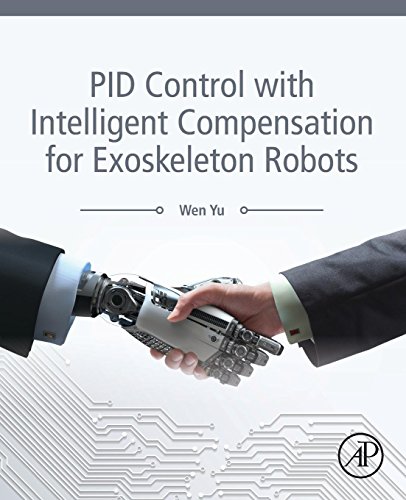

Most ebook files are in PDF format, so you can easily read them using various software such as Foxit Reader or directly on the Google Chrome browser.
Some ebook files are released by publishers in other formats such as .awz, .mobi, .epub, .fb2, etc. You may need to install specific software to read these formats on mobile/PC, such as Calibre.
Please read the tutorial at this link. https://ebooknice.com/page/post?id=faq
We offer FREE conversion to the popular formats you request; however, this may take some time. Therefore, right after payment, please email us, and we will try to provide the service as quickly as possible.
For some exceptional file formats or broken links (if any), please refrain from opening any disputes. Instead, email us first, and we will try to assist within a maximum of 6 hours.
EbookNice Team

Status:
Available4.4
15 reviews(Ebook) PID Control with Intelligent Compensation for Exoskeleton Robots 1st Edition by Wen Yu - Ebook PDF Instant Download/Delivery: 9780128133804 ,0128133805
Full download (Ebook) PID Control with Intelligent Compensation for Exoskeleton Robots 1st Edition after payment

Product details:
ISBN 10: 0128133805
ISBN 13: 9780128133804
Author: Wen Yu
PID Control with Intelligent Compensation for Exoskeleton Robots explains how to use neural PD and PID controls to reduce integration gain, and provides explicit conditions on how to select linear PID gains using proof of semi-global asymptotic stability and local asymptotic stability with a velocity observer. These conditions are applied in both task and joint spaces, with PID controllers compensated by neural networks. This is a great resource on how to combine traditional PD/PID control techniques with intelligent control. Dr. Wen Yu presents several leading-edge methods for designing neural and fuzzy compensators with high-gain velocity observers for PD control using Lyapunov stability.
Proportional-integral-derivative (PID) control is widely used in biomedical and industrial robot manipulators. An integrator in a PID controller reduces the bandwidth of the closed-loop system, leads to less-effective transient performance and may even destroy stability. Many robotic manipulators use proportional-derivative (PD) control with gravity and friction compensations, but improved gravity and friction models are needed. The introduction of intelligent control in these systems has dramatically changed the face of biomedical and industrial control engineering.
(Ebook) PID Control with Intelligent Compensation for Exoskeleton Robots 1st Edition Table of contents:
Chapter 1: Preliminaries
Abstract
1.1. Exoskeleton robots
1.2. Control of exoskeleton robots
1.3. Neural network and fuzzy systems
1.4. PD and PID control
1.5. PD and PID control with compensations
1.6. Robot admittance control
1.7. Trajectory generation of exoskeleton robots
Bibliography
Chapter 2: Stable PID Control and Systematic Tuning of PID Gains
Abstract
2.1. Stable PD and PID control for exoskeleton robots
2.2. PID parameters tuning in closed-loop
2.3. Application to an exoskeleton
2.4. Conclusions
Bibliography
Chapter 3: PID Control in Task Space
Abstract
3.1. Linear PID control in task space
3.2. Linear PID control with velocity observers
3.3. Experimental results
3.4. Conclusions
Bibliography
Chapter 4: PD Control with Neural Compensation
Abstract
4.1. PD control with high gain observer
4.2. PD control with neural compensator
4.3. PD control with velocity estimation and neural compensator
4.4. Simulation
4.5. Conclusions
Bibliography
Chapter 5: PID Control with Neural Compensation
Abstract
5.1. Stable neural PID control
5.2. Neural PID control with unmeasurable velocities
5.3. Neural PID tracking control
5.4. Experimental results of the neural PID
5.5. Conclusions
Bibliography
Chapter 6: PD Control with Fuzzy Compensation
Abstract
6.1. PD control with fuzzy compensation
6.2. Membership functions learning and stability analysis
6.3. Experimental comparisons
6.4. Conclusion
Bibliography
Chapter 7: PD Control with Sliding Mode Compensation
Abstract
7.1. PD control with parallel neural networks and sliding mode
7.2. PD control with serial neural networks and sliding mode
7.3. Simulation
7.4. Conclusions
Bibliography
Chapter 8: PID Admittance Control in Task Space
Abstract
8.1. Human–robot cooperation via admittance control
8.2. PID admittance control in task space
8.3. PID admittance control in task space with neural compensation
8.4. Admittance PD control with Jacobian approximation
8.5. Admittance control with adaptive compensations
8.6. Experimental results
8.7. Conclusions
Bibliography
Chapter 9: PID Admittance Control in Joint Space
Abstract
9.1. PD admittance control
9.2. PD admittance control with adaptive compensations
9.3. PD admittance control with sliding mode compensations
9.4. PID admittance control
9.5. Experimental results
9.6. Conclusion
Bibliography
Chapter 10: Robot Trajectory Generation in Joint Space
Abstract
10.1. Codebook and key-points generation
10.2. Joint space trajectory generation with a modified hidden Markov model
10.3. Experiments of learning trajectory
10.4. Conclusions
Bibliography
Appendix A: Design of Upper Limb Exoskeletons
A.1. Heavy duty exoskeleton robot
A.2. Portable exoskeleton robot
Bibliography
Bibliography
Index
People also search for (Ebook) PID Control with Intelligent Compensation for Exoskeleton Robots 1st Edition:
pid controller advantages and disadvantages
pid compensation
pid controller delay compensation
pid controller integral windup
advantages of a pid controller
Tags: Wen Yu, PID Control, Intelligent Compensation, Exoskeleton Robots